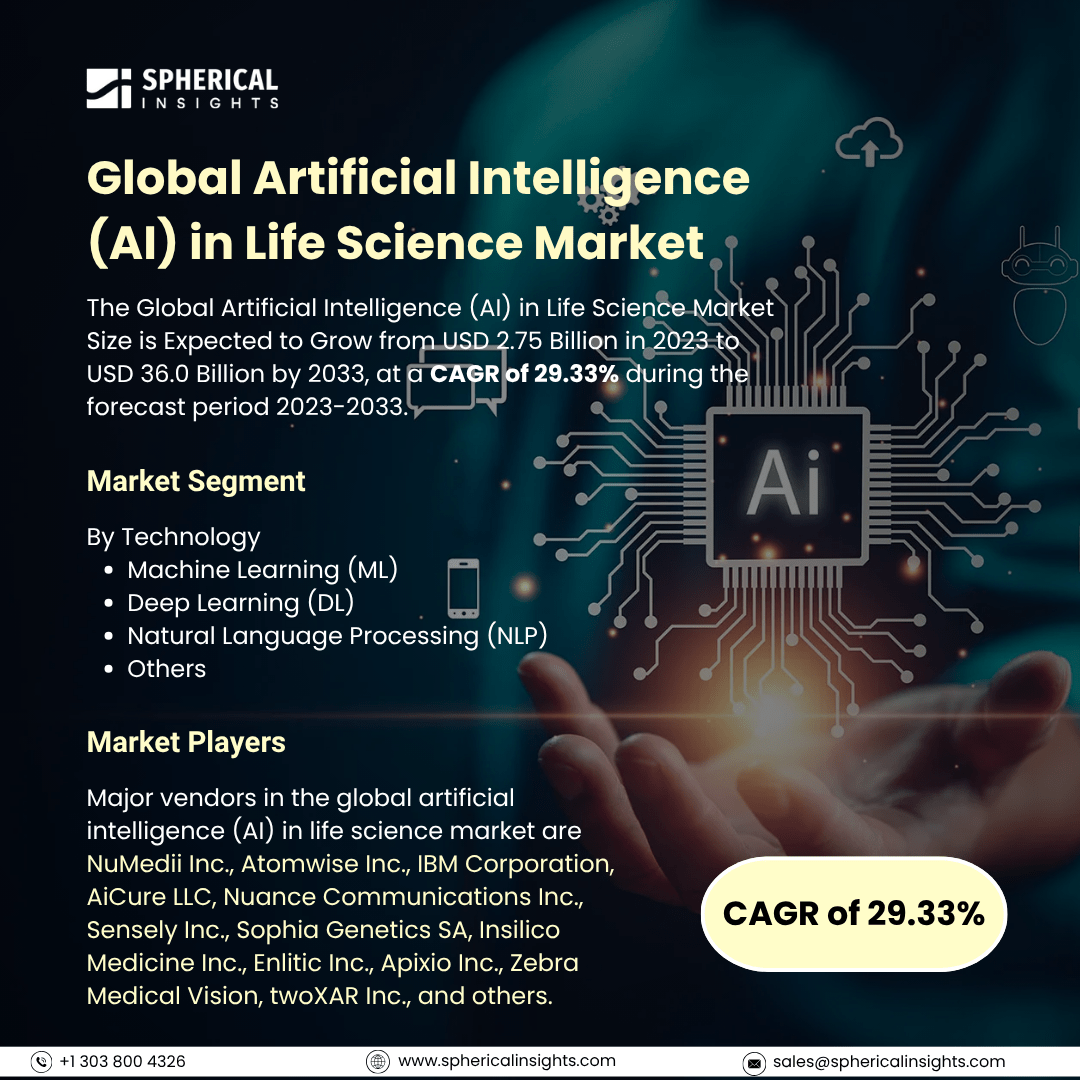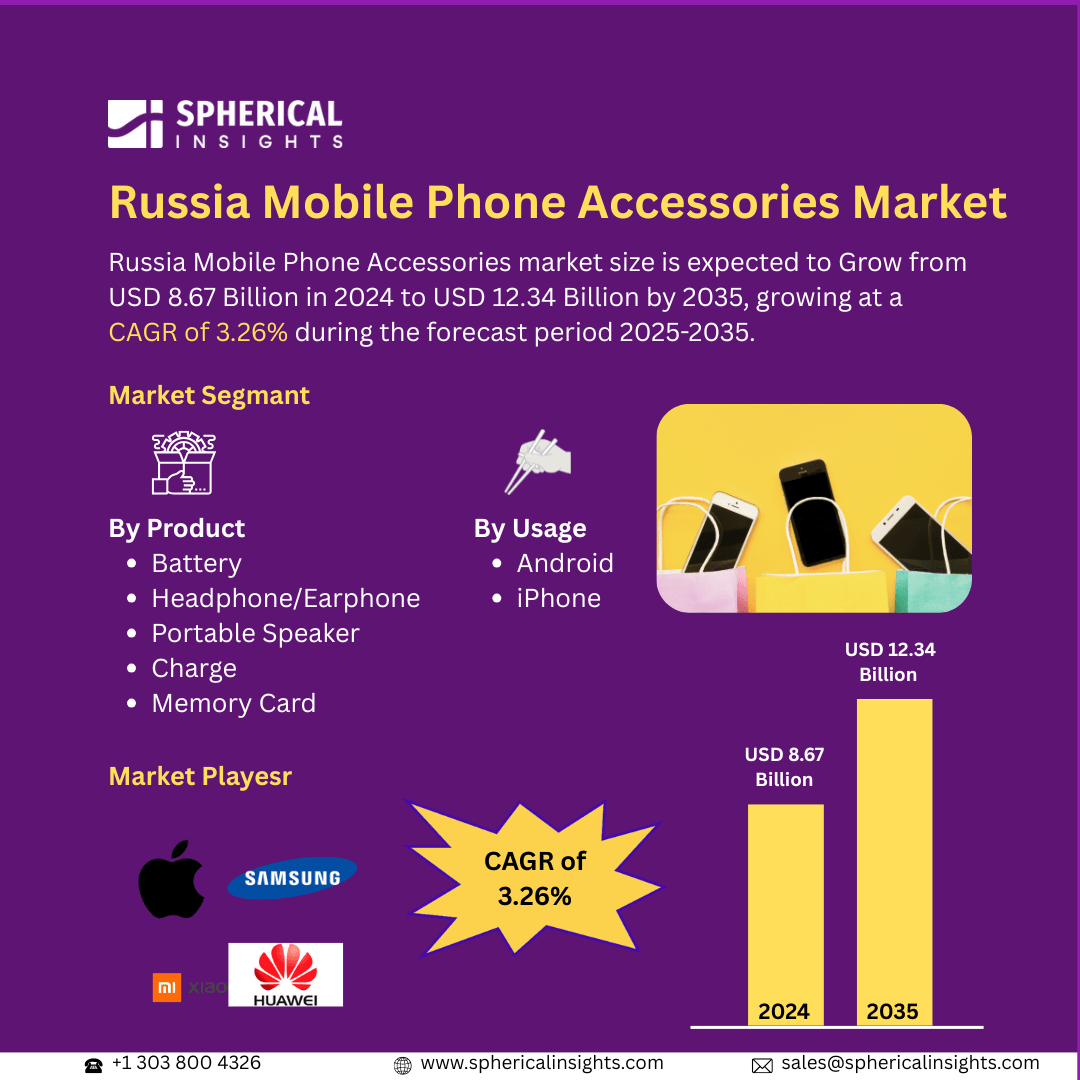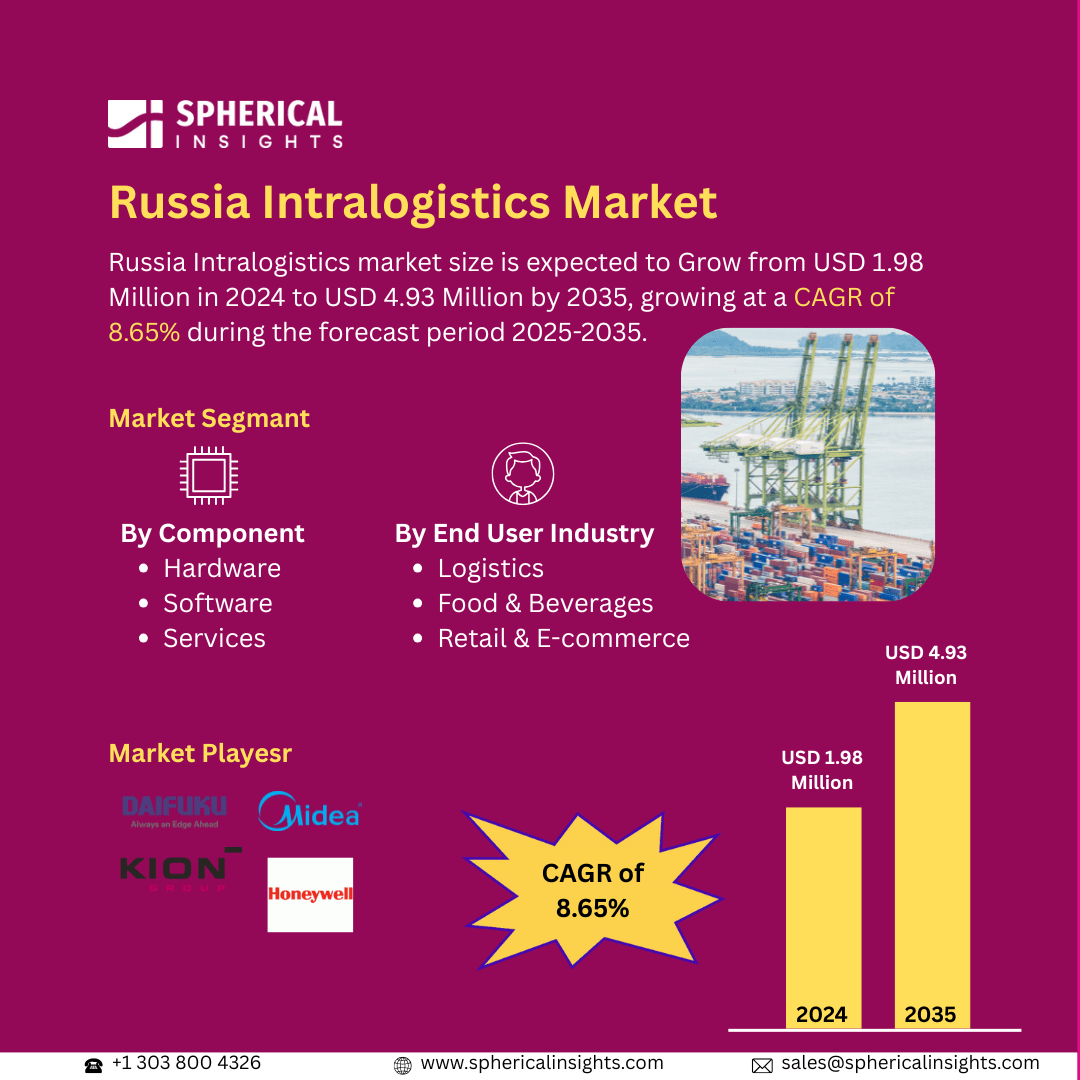Global Artificial Intelligence (AI) in Life Science Market Size To Exceed USD 36.0 Billion by 2033
According to a research report published by Spherical Insights & Consulting, The Global Artificial Intelligence (AI) in Life Science Market Size is Expected to Grow from USD 2.75 Billion in 2023 to USD 36.0 Billion by 2033, at a CAGR of 29.33% during the forecast period 2023-2033.
Browse 210 market data Tables and 45 Figures spread through 190 Pages and in-depth TOC on the Global Artificial Intelligence (AI) in Life Science Market Size, Share, and COVID-19 Impact Analysis, By Technology (Machine Learning (ML), Deep Learning (DL), Natural Language Processing (NLP), and Others), By Application (Drug Discovery, Medical Diagnosis, Biotechnology, Clinical Trials, Precision & Personalized Medicine, Patient Monitoring, Novel Drug Candidates, Drug Optimization & Repurposing Preclinical Testing & Approval, Drug Monitoring, Finding New Diseases Associated Targets & Pathways, Understanding Disease Mechanisms, Aggregating & Synthesizing Information, Formation & Qualification of Hypotheses, De Novo Drug Design, and Finding Drug Targets of an Old Drug), and By Region (North America, Europe, Asia-Pacific, Latin America, Middle East, and Africa), Analysis and Forecast 2023 – 2033.
The global artificial intelligence (AI) in life science market refers to the global industry focused on the development, integration, and application of AI technologies such as machine learning, natural language processing, and computer vision across various sectors of the life sciences. This includes drug discovery, clinical trials, diagnostics, personalized medicine, and biotechnology research. AI helps accelerate data analysis, improve decision-making, enhance patient outcomes, and reduce time and costs in life sciences operations. Furthermore, driving factors for the global Artificial Intelligence (AI) in life science market include increasing demand for faster drug discovery, personalized medicine, and predictive analytics. Advancements in machine learning, big data integration, and growing healthcare digitization are enhancing research efficiency. Rising investments from pharmaceutical companies and governments further accelerate AI adoption across diagnostics, genomics, and clinical trials, fueling market growth. However, restraining factors for the global Artificial Intelligence (AI) in life science market include high implementation costs, data privacy concerns, and a lack of standardized regulatory frameworks. Additionally, limited access to quality datasets, a shortage of skilled AI professionals, and resistance to change within traditional healthcare and research institutions hinder widespread adoption and integration of AI technologies in life science applications.
The machine learning (ML) segment accounted for the largest share in 2023 and is anticipated to grow at a significant CAGR during the forecast period.
On the basis of the technology, the global artificial intelligence (AI) in life science market is divided into machine learning (ML), deep learning (DL), natural language processing (NLP), and others. Among these, the machine learning (ML) segment accounted for the largest share in 2023 and is anticipated to grow at a significant CAGR during the forecast period. The segmental growth is attributed to its ability to analyze vast datasets, uncover patterns, and accelerate drug discovery and diagnostics. ML enhances predictive accuracy in clinical outcomes and streamlines research processes. Growing adoption across life sciences for precision medicine and personalized treatment supports its continued significant CAGR during the forecast period.
The drug discovery segment accounted for a significant share of the global artificial intelligence (AI) in life science market in 2023 and is predicted to grow at a rapid pace over the forecast period.
On the basis of the application, the global artificial intelligence (AI) in life science market is divided into drug discovery, medical diagnosis, biotechnology, clinical trials, precision & personalized medicine, patient monitoring, novel drug candidates, drug optimization & repurposing preclinical testing & approval, drug monitoring, finding new diseases associated targets & pathways, understanding disease mechanisms, aggregating & synthesizing information, formation & qualification of hypotheses, de novo drug design, and finding drug targets of an old drug. Among these, the drug discovery segment accounted for a significant share of the global artificial intelligence (AI) in life science market in 2023 and is predicted to grow at a rapid pace over the forecast period. The segmental growth is attributed to AI's ability to accelerate target identification, molecule screening, and predictive modeling. By reducing time and cost in R&D, AI enhances efficiency and success rates in drug development, driving rapid growth in this segment throughout the forecast period.
North America is projected to hold the largest share of the global artificial intelligence (AI) in life science market over the forecast period.
North America is projected to hold the largest share of the global artificial intelligence (AI) in life science market over the forecast period. The regional growth is attributed to its advanced healthcare infrastructure, strong presence of leading AI and biotech companies, and significant investment in R&D. Supportive government initiatives, high adoption of digital technologies, and availability of skilled professionals further strengthen the region’s market leadership.
Asia Pacific is expected to grow at the fastest CAGR in the global artificial intelligence (AI) in life science market during the forecast period. The regional Growth is attributed to the rapid advancements in healthcare infrastructure, increasing investments in AI research, and government support for digital health initiatives. Rising prevalence of chronic diseases and expanding biotech sectors in countries like China, India, and Japan further drive this accelerated growth.
Company Profiling
Major vendors in the global artificial intelligence (AI) in life science market are NuMedii Inc., Atomwise Inc., IBM Corporation, AiCure LLC, Nuance Communications Inc., Sensely Inc., Sophia Genetics SA, Insilico Medicine Inc., Enlitic Inc., Apixio Inc., Zebra Medical Vision, twoXAR Inc., and others.
Key Target Audience
- Market Players
- Investors
- End-users
- Government Authorities
- Consulting and Research Firm
- Venture capitalists
- Value-Added Resellers (VARs)
Recent Development
In March 2024, the first artificial intelligence-powered social media comment moderator for the life sciences industry was launched by Klick Health and is called Klick Comment Moderator AI (KCM AI). KCM AI increases the efficacy and interactivity of community management while also improving PV identification and reporting through the use of Microsoft Azure AI and a proprietary Klick model trained on almost 400,000 historical comments.
Market Segment
This study forecasts revenue at global, regional, and country levels from 2023 to 2033. Spherical Insights has segmented the global artificial intelligence (AI) in life science market based on the below-mentioned segments:
Global Artificial Intelligence (AI) in Life Science Market, By Technology
- Machine Learning (ML)
- Deep Learning (DL)
- Natural Language Processing (NLP)
- Others
Global Artificial Intelligence (AI) in Life Science Market, By Application
- Drug Discovery
- Medical Diagnosis
- Biotechnology
- Clinical Trials
- Precision & Personalized Medicine
- Patient Monitoring
- Novel Drug Candidates
- Drug Optimization & Repurposing Preclinical Testing & Approval
- Drug Monitoring
- Finding New Diseases Associated Targets & Pathways
- Understanding Disease Mechanisms
- Aggregating & Synthesizing Information
- Formation & Qualification of Hypotheses
- De Novo Drug Design
- Finding Drug Targets of an Old Drug
Global Artificial Intelligence (AI) in Life Science Market, By Regional
- North America
- Europe
- Germany
- UK
- France
- Italy
- Spain
- Russia
- Rest of Europe
- Asia Pacific
- China
- Japan
- India
- South Korea
- Australia
- Rest of Asia Pacific
- South America
- Brazil
- Argentina
- Rest of South America
- Middle East & Africa
- UAE
- Saudi Arabia
- Qatar
- South Africa
- Rest of the Middle East & Africa



